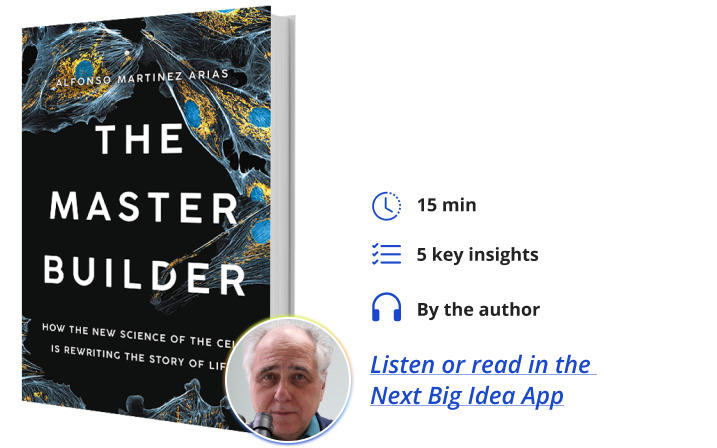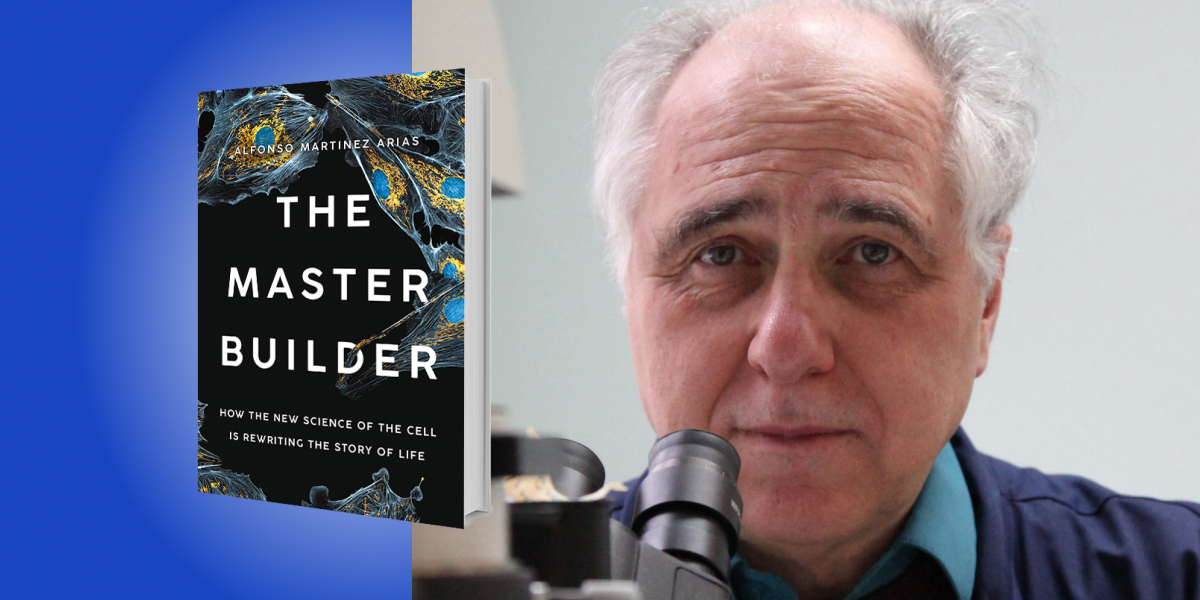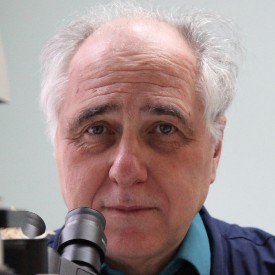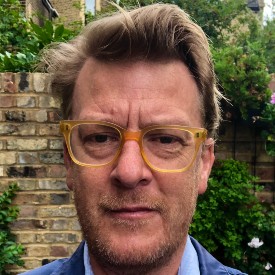Alfonso Martinez Arias is ICREA Research Professor in the department of systems bioengineering of the Universitat Pompeu Fabra in Barcelona. The recipient of numerous awards, he is co-author of the biology textbook Principles of Development, which was awarded the Royal Society of Biology book prize.
Below, Alfonso shares five key insights from his new book, The Master Builder: How the New Science of the Cell Is Rewriting the Story of Life. Listen to the audio version—read by Alfonso himself—in the Next Big Idea App.

1. Cells are us.
DNA and its genes are deeply embedded in our culture. Who we are, our health, some people would even claim our life span, all is considered to be written in our genes. But, is it?
When you look into the mirror you don’t see genes, and when you listen to a voice, smell flowers, or taste food, you don’t do it through your genes. What you see in the mirror is cells and you use special cells connected to circuits of other cells, neurons, to hear, smell or taste. Furthermore, you were never a gene. Once you were a cell, however, a lonely single cell, deep inside the womb of your mother.
If you stop and think, it is surprising that we have made an icon of our world something we cannot see: genes. We don’t know much about what we actually are made up of and can see: cells.
Cells are said to be the building blocks of life but they are much more than passive brick-like entities holding us together. You are the work of 30 trillion cells, each a mesh of proteins, sugars and fats, rigged into a web of roads that link functional compartments: protein factories, sorting stations, signaling centers, and flexible structural frameworks.
At their center, in a vault, is the DNA and its genes. When you get to know those cells, you realize that each one is a living structure, imbued with an ability to sense, decide, interact with its neighbors, and morph with purpose. There are many kinds of cells, neurons that connect you to the world, muscles that allow you to move, photoreceptors that allow you to see, red blood cells that help you breathe, intestinal cells that absorb nutrients, skin cells that protect you from the environment. Cells are both engineers and builders.
2. The genome is the toolbox of the cell.
It would be foolish to argue that genes have nothing to do with who and what we are. They do. But they are not the masters of our being and fate that they have been made out to be. The well-settled cultural importance of the gene can probably be traced to Richard Dawkins and his Selfish Gene idea that claimed the gene as the essence of biology. That idea suggested that in the grand scheme of things, genes rule and, as he put it, organisms are survival machines created by genes for their spread into eternity. For Dawkins, cells do not exist.
“Cells are said to be the building blocks of life but they are much more than passive brick-like entities holding us together.”
Surprisingly, it is when we try to describe a genome that we realize that something is missing between the gene and the organism. When the first draft of the human genome was unveiled, it was hailed as “the book of life”, “the instruction manual” to make a human being. But if you try to read and use such a manual, you realize that this is an impossible task. There is no such manual and there is certainly not one that we can understand.
The genome is also often referred to as a “toolbox.” This is a better analogy but one that begs the question of who or what uses the tools in the box. Could it be the genes themselves? It must be a strange toolbox then, in which its contents are the users. When you think about it, in the context of an organism, the only possible user is, of course, the cell.
It is the cell as a sensing, deciding, calculating entity that reads the environment, its neighbors, and its state. A cell chooses which genes to activate and use to fulfill its needs or those of the community it belongs to. The genome contains information for tools and materials that cells use to build other cells, to repair themselves, to create societies; ensembles that we call organs and tissues weave them into an organism. Far from being an instruction manual for an organism, a genome is a collection of tools and materials at the service of life’s true expert builders: cells.
3. The cell is a master builder.
If there is a situation in which we see the creative power and abilities of cells in full flow, it is in the making of an embryo: the crucible of an organism, an ever-changing scaffold which cells sculpt to build and bring together tissues and organs.
Most people studying embryos will tell you that an organism is made through a sequence of genes controlling genes, that cells are different because they express different genes that lead to new cohorts of genes. While there is some truth in this account, it is limited, and it does not explain what makes cells look different from each other. Which genes determine the size of a cell, which ones decide that we only have two arms, five fingers, and one liver? Recently a survey concluded that there are about 12,000 genes contributing to our height, but enumerating them does not tell us about height. This is not a good description of such an important feature if you ask me. The telephone directory of your town is not a representation of its urban architecture and social structure. More importantly, it does not tell you how it’s come to be.
“It is cells that control genes and not genes that determine cells.”
If we want to know what those numbers of genes mean, we have to ask cells. It is cells that have developed the ability to interpret those genes, to count, sense, and shape the space they create. To do this they draw from the toolbox that lies waiting to be used in the genome.
It is cells that control genes and not genes that determine cells. Genes can create time but it is cells that create space and control time, particularly when building embryos. It is cells that determine how big every organ is, the shape of your face and the length of your limbs.
4. Cells talk to each other and we are learning their language.
In the 1930s, a young woman by the name of Hilde Mangold, working in the laboratory of a famed embryologist in Germany, did an experiment. She took a piece of a very early newt embryo, from a region that would give rise to part of the head, put it where the tail should arise from, and waited. The result was startling: Siamese animals. Furthermore, upon close inspection, she realized that this happened because the transplanted cells had told the surrounding ones to change their plans and make a new body. The conclusion: cells talk to each other, give and take instructions, and use these exchanges to build organs, tissues, and organisms.
Further work showed that this happens in all embryos during their development and led to the discovery of the language of cells. Some of the words are chemicals and some are mechanical, like forces due to pressure or flows. The language is universal and cells use it to choose and control genes, to create and use space and time.
Over the last ten years, we have started to speak this language and so, to interact with cells. We are not yet very good, but starting with embryonic stem cells, we have the potential to become any cell of an organism using our very rudimentary cellular language skills. We can potentially create mini-organs: brains, livers, intestines, and, more recently, structures that resemble very early human embryos. The aim of this work is to study and understand issues of human disease and, at some point in the future, to create replacement organs and tissues. At the same time, this work is raising important questions about our nature and our future as a species.
5. A cell’s eye-view of biology expands views of our nature and self.
You might be surprised to learn that you are not the same being that you were a month ago. In that time your intestine has changed ten times, your skin three or four times and your blood has received large numbers of fresh red blood cells, to the tune of two million per second! Even your bones change, but at slower pace; they take about ten years to turn over. There are exceptions to this renewal: your heart and your brain, but much of your encasing and your body is changing all the time, though we don’t yet understand the reasons for that.
“We are not going to make progress simply by cataloging the genes [cells] express.”
Over the same period of time, your genome has remained pretty much the same. So, if we want to understand who and what we are, we need to look into the working of cells. What we need is a cell’s, not a gene’s eye-view of ourselves.
A critic might argue that by highlighting the powers of cells over the power of genes, I am endowing cells with mystical abilities that do not help advance our understanding of life any more than reductionist genetics. I concede that it is early days in our understanding of the cell, but it is also true that we are not going to make progress simply by cataloging the genes they express; we need to engage with their properties, find the elements that drive them and learn to control them. We already have many examples of how cells rule our lives, our health, and our being. What we now need is understanding.
I sense a shift in our views about how we are made and who we are in which genes are integrated within the activity of cells. Such a cell-based understanding of biological systems promises to help us tackle diseases, improve our lives, and also see ourselves in a richer and less deterministic view than that provided by our current gene-centric view of biology.
To listen to the audio version read by author Alfonso Martinez Arias, download the Next Big Idea App today:































